
Kingfishers are a family, the Alcedinidae, of small to medium-sized, brightly coloured birds in the order Coraciiformes. They have a cosmopolitan distribution, with most species living in the tropical regions of Africa, Asia, and Oceania, but also can be seen in Europe. They can be found in deep forests near calm ponds and small rivers. The family contains 116 species and is divided into three subfamilies and 19 genera. All kingfishers have large heads, long, sharp, pointed bills, short legs, and stubby tails. Most species have bright plumage with only small differences between the sexes. Most species are tropical in distribution, and a slight majority are found only in forests.

The river kingfishers or pygmy kingfishers, subfamily Alcedininae, are one of the three subfamilies of kingfishers. The river kingfishers are widespread through Africa and east and south Asia as far as Australia, with one species, the common kingfisher also appearing in Europe and northern Asia. This group includes many kingfishers that actually dive for fish. The origin of the subfamily is thought to have been in Asia.

The sacred kingfisher is a medium-sized woodland kingfisher that occurs in mangroves, woodlands, forests and river valleys in Australia, New Zealand and other parts of the western Pacific.
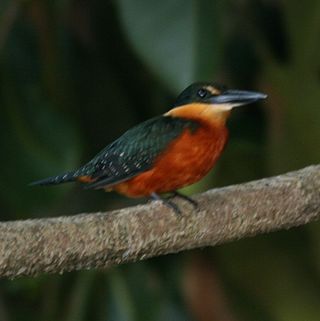
The American green kingfishers are the kingfisher genus Chloroceryle, which are native to tropical Central and South America, with one species extending north to south Texas.

The Vanuatu kingfisher or chestnut-bellied kingfisher is a medium-sized kingfisher found only on the islands of Espiritu Santo, Malo and Malakula in Vanuatu.

Halcyon is a genus of the tree kingfishers, near passerine birds in the subfamily Halcyoninae.
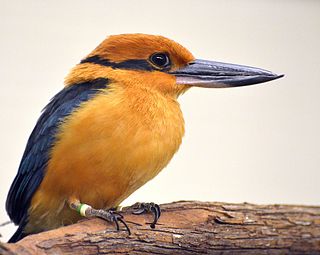
The Guam kingfisher is a species of kingfisher from the United States Territory of Guam. It is restricted to a captive breeding program following its extinction in the wild due primarily to predation by the introduced brown tree snake.

The collared kingfisher is a medium-sized kingfisher belonging to the subfamily Halcyoninae, the tree kingfishers. It is also known as the white-collared kingfisher, black-masked kingfisher or mangrove kingfisher. It has a wide range extending from the Red Sea across southern Asia to Polynesia. A number of subspecies and subspecies groups have been split from this species including the Pacific kingfisher, the islet kingfisher, the Torresian kingfisher, the Mariana kingfisher, and the Melanesian kingfisher.

The lazuli kingfisher is a species of bird in the family Alcedinidae. It can be found on the islands of Seram, Ambon and Haruku. Found singly and in pairs in lowland wooded areas, including cultivated areas and mangroves. Pale blue underside is unique among kingfishers in its limited south Moluccan range. Rowdy vocalizations include repetitive “ker-chick” series and “ki-ki-ki-ki…” calls. It gets its name due to its colour being reminiscent of Lapis Lazuli.
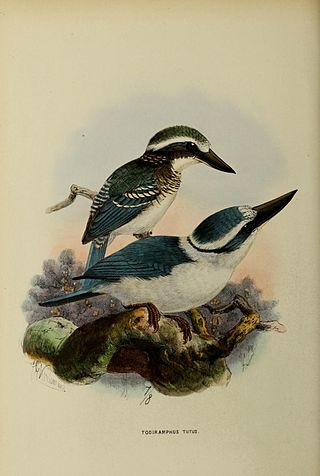
The chattering kingfisher is a species of bird in the kingfisher family Alcedinidae. The species is found in the Cook Islands and the Society Islands in French Polynesia.

The Society kingfisher or Tahiti kingfisher is a species of bird in the family Alcedinidae. It is endemic to the Society Islands of French Polynesia. Its natural habitats are subtropical or tropical moist lowland forest and subtropical or tropical moist montane forest.

Winchell's kingfisher or the rufous-lored kingfisher, is a species of bird in the family Alcedinidae, the kingfishers. It is endemic to the Philippines, its natural habitat being lowland forests. It is threatened by deforestation, and the International Union for Conservation of Nature (IUCN) has assessed it as a vulnerable species.

The tree kingfishers, also called wood kingfishers or Halcyoninae, are the most numerous of the three subfamilies of birds in the kingfisher family, with around 70 species divided into 12 genera, including several species of kookaburras. The subfamily appears to have arisen in Indochina and Maritime Southeast Asia and then spread to many areas around the world. Tree kingfishers are widespread through Asia and Australasia, but also appear in Africa and the islands of the Pacific and Indian Oceans, using a range of habitats from tropical rainforest to open woodlands.
The Mangareva kingfisher, also known as Tuamotu kingfisher, is a species of kingfisher in the family Alcedinidae, endemic to Niau in French Polynesia. It is classified as critically endangered.
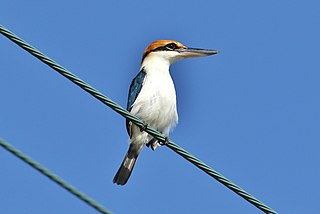
The rusty-capped kingfisher or Palau kingfisher is a species of bird in the family Alcedinidae. It is endemic to Palau. The natural habitat of this species is subtropical or tropical moist lowland forests. It was formerly considered to be a subspecies of the Micronesian kingfisher.
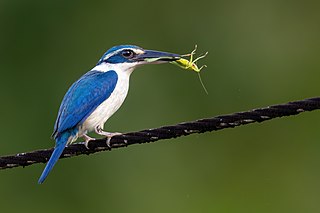
The Pacific kingfisher is a medium-sized kingfisher belonging to the subfamily Halcyoninae, the tree kingfishers. It has a wide range throughout the South Pacific islands. It was previously considered a subspecies of the collared kingfisher.
The islet kingfisher is a species of bird in the family Alcedinidae.
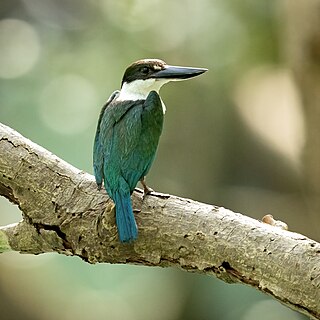
The Torresian kingfisher is a species of bird in the family Alcedinidae. It is found in southern New Guinea and in Australia. Its natural habitats are subtropical or tropical moist lowland forests, mangroves, and plantations. It was formerly considered a subspecies of the collared kingfisher.

The Mariana kingfisher is a species of bird in the family Alcedinidae. It is endemic to the Northern Mariana Islands. Its natural habitats are subtropical or tropical moist lowland forests and plantations. It was formerly considered a subspecies of the collared kingfisher.

The Melanesian kingfisher is a species of bird in the family Alcedinidae. It is endemic to the Bismarck Archipelago and the northwest and central Solomon Islands. Its natural habitats are subtropical or tropical moist lowland forests and plantations. It was formerly considered a subspecies of the collared kingfisher.

















